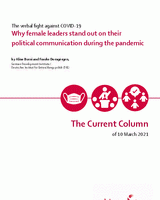The verbal fight against COVID-19
Why female leaders stand out on their political communication during the pandemic
Burni, Aline / Frauke DomgörgenThe Current Column (2021)
German Development Institute / Deutsches Institut für Entwicklungspolitik (DIE), The Current Column of 10 March 2021
During the COVID-19 pandemic, female leaders have been portrayed by the media as more competent and efficient in dealing with the outbreak. A study by the University of Reading has provided evidence that countries led by women entered lockdown significantly earlier. Consequently, these countries suffered less in terms of COVID-19 infections and deaths, at least in the first wave.
What could explain that female leaders have conducted a successful mitigation of the pandemic? The explanation relies on a combination of structural and leadership agency factors. Structural factors include a country’s geographic location, population density, health infrastructure, relations at the international level, and the governance system.
Regarding leadership, the study emphasises the proactive attitude of female compared to male leaders (earlier lockdowns) that helped to avoid deaths. In addition, an effective crisis communication strategy and the ability to connect, in different ways, to the citizens of their countries seem to make a difference. Female heads of government have used various crisis communication approaches to explain the developments of the pandemic and to mobilise compliance with governmental measures.
In general, there is not one successful model of crisis communication. However, it appears that communication has been more effective when based on a balance between science, rationality and emotions simultaneously, especially when the leader expresses empathy. Countries in which the leader communicated clearly and established trust with citizens were better equipped to limit the harm of COVID-19. We provide some examples of female leaders’ crisis communication below.
The most prominent European leader, Angela Merkel, relied on an objective, science-based communication approach early in the pandemic. She made efforts to explain the R value and justified her strategy with infection rate data and clearly stated objectives, based on evidence. Merkel has been praised for her communication style and the engagement of her scientific background in many parts of the world. Furthermore, she expressed compassion for how painful social distancing and isolation would be in particular for the elderly.
Adopting a more emotional perspective, Jacinda Ardern from New Zealand showed a balanced and comprehensive communication, allowing space for questions, participation and inclusiveness. According to leadership experts, her communication approach evolved from an institutional role to a leader sharing a common experience and showing empathy with the public. Research shows that empathy and compassion are among the critical attributes of leadership communication shaping individuals’ perception of a crisis and the ability of the leader to respond to it.
A quick and persuasive communication style has also proven effective in Finland, under the head of government Sanna Marin. To some extent similar to New Zealand, Finland had clear lockdown policies for COVID-19 hotspots from the beginning. The measures were restrictive, but accepted by the citizens. The balance between decisiveness and openness to expert knowledge has emerged as the defining strategy for Marin to secure public support in the fight against COVID-19. In addition, the contact-tracking app is widely used and digital home schooling was rapidly implemented due to the broad availability of technical equipment at Finnish schools. These digital tools allowed the Finnish Prime Minister to hold an online Q&A session for children to respond to questions with a direct and personal approach.
Common elements of the discursive response of female leaders during the pandemic seem to be their thoughtfulness, their ability to handle risks responsibly, and to act with empathy and knowledge. Equally important has been their flexibility to adapt government responses to evolving scientific evidence and their effort to reach out and speak to vulnerable groups – such as children, the elderly, and minorities. The mix between empathic communication and science-based policy-making is not an ability restricted to female leaders, of course, but due to socially constructed gendered identities and the way that this pandemic blurred the boundaries between private and public life, women leaders were in a better position to take decisive measures, show emotions and foster social cohesion.
To sum up, the crisis communication style of female leaders has been an important factor to promote legitimacy of and compliance with lockdown measures, while also offering affective support and longer-term vision to overcome the crisis. On the occasion of International Women's Day, there are many reasons to celebrate the foresight and leadership of women around the world.


